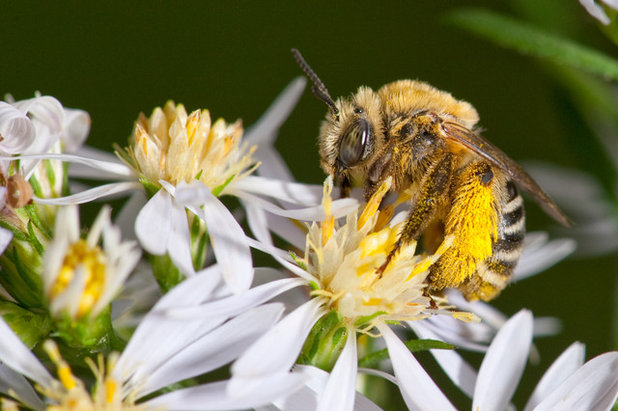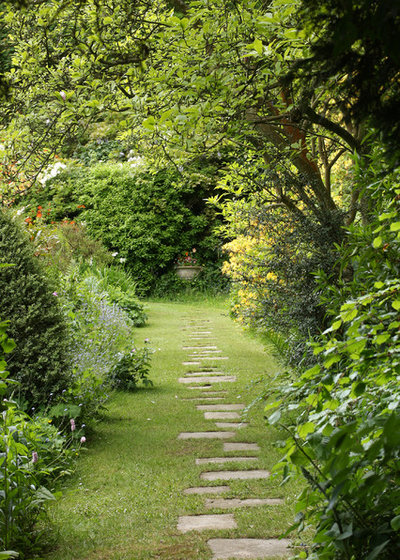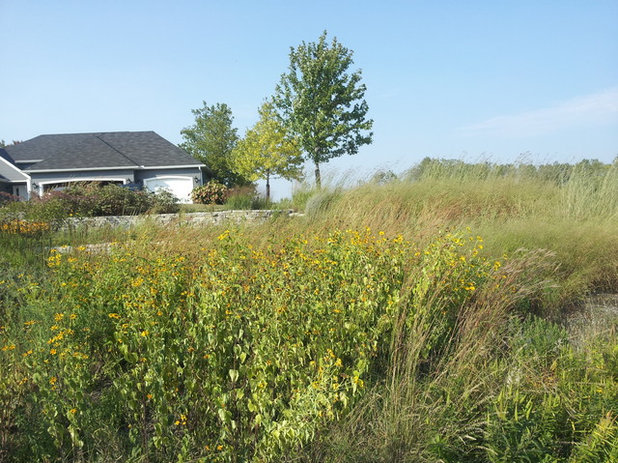No matter your aesthetic preference — from formal to informal, straight lines to wavy borders — you can garden in a way that honors and supports wildlife and the land that intersects with your landscape. From attracting pollinators and birds to sequestering carbon and filtering water, native plants can fit the bill in almost any designed space. Here are a few strategies to help you consider how to best garden for nature.

Holm Design & Consulting LLC
1. Incorporate host plants for insects. Supporting pollinators such as native bees and butterflies is a hot-button issue right now. Often this discussion focuses on nectar and pollen — just flowers. While these are important parts for gardeners, as flowers are pretty, and for insects, as wildlife is hungry, we also need to focus on host plants where pollinators raise their young.
The following larvae host plants are native to various regions of the United States and are available at native-plant nurseries: milkweed (
Asclepias spp., USDA zones 3 to 9, depending on species; find your zone), golden Alexanders (
Zizia aurea,
zones 3 to 8), baptisia (
Baptisia spp., zones 3 to 9), American senna (
Senna hebecarpa, zones 4 to 8), little bluestem (
Schizachyrium scoparium,
zones 2 to 9), Indian grass (
Sorghastrum nutans, zones 4 to 9) and asters, just to name a few. Check with local nurseries, university extension offices or farmers markets to learn more about host plants native to your region.
How to Find the Right Native Plants for Your Yard
It’s important to remember that most butterfly and moth species can lay eggs only on certain plant species, and there are even native bees, called oligolectic bees, that use the pollen only from a certain plant genus or species to complete their life cycle.
A good plant does at least triple duty: It produces copious amounts of attractive pollen, which is the nutritious part of a bloom; it is a good place on which to lay eggs and good for being eaten by caterpillars; and it helps amend the soil, improving rainwater penetration and contributing to soil life.

Rebecca Smith Garden Design
2. Plant a mix of root systems to beat weeds and filter water. More and more we’re thinking about what our gardens are doing at and below the soil line: how plants improve soil, increase drainage and keep runoff out of storm drains. Believe it or not, these concerns align with combating weeds in our landscapes.
When our gardens are thick with plants of varying heights and varying leaf structures, weeds get shaded and crowded out — the leaves and plants aboveground steal the sunlight. Plants can also outcompete many weeds as they hunt for nutrients below ground through their roots. That underground competition works especially well for garden plants if you layer plants below ground too.
Include plants with deep taproots, such as baptisia, milkweed and compass plant (
Silphium laciniatum); those with more fibrous root zones, such as little bluestem and sideoats grama (
Bouteloua curtipendula); and oru native sedges (Carexx spp.) These various root systems not only outcompete weeds, but they also open up and improve the soil, creating more life and increasing water-holding capacity. An acre of mature prairie or meadow can absorb 9 inches of rain every hour before runoff occurs.
Learn more about how plants can reduce stormwater runoff

reGEN Land Design
3. Clean the air with a diversity of plant types. While your garden hosts insects and filters water, it also absorbs carbon from the atmosphere and stores it underground. Let’s take prairie plants, many of which have ranges that extend far east and west from the Great Plains — some all the way to both oceans.
Mature prairie plants can sequester as much carbon below ground in their roots as mature woodland can aboveground. The difference between the two is that when trees die, they release the stored carbon from the decaying trunks, whereas prairie plants like grasses, with their deep root systems, keep that carbon in the soil. That’s one reason so much farmland is on what used to be prairie—the soils are very rich. Trees play an important part in cleaning our air and cooling urban areas, but so do flowers and grasses. A diverse and thickly planted landscape provides maximum benefit.
This year think about all the ways in which your garden can be beautiful and have a purpose that appeals not only to your aesthetic senses but also to the needs of wildlife and the larger environment. Your garden can provide food and shelter for other species above and below the soil line, all while filtering water and cleaning the air. Your garden can make a difference. Your garden matters.





